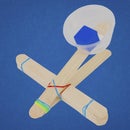Introduction: Craft Stick Mouse Trap
This project emulates the same mechanism that is used in a real mousetrap.
You can find the lesson plan, 1-page project sheet, and more project ideas at STEM-Inventions.com
Step 1: Materials
Please message me to report broken links. All of these materials are used in my other Instructables for kids, so your purchases can be used across multiple projects.
Materials for one craft stick mouse trap:
- Craft sticks
- Craft cubes
- Cubes with holes (for the hinge)
- 1/8" dowels
- Cable ties
- Rubber bands
- Something to cut craft sticks
- Hot glue with safety nozzle
- Masking tape
When you make a purchase through these links, I may earn an affiliate commission at zero cost to you.
Step 2: Make the Base and Arm
The hinge for the mousetrap arm is created by threading a thin skewer through three cubes with holes. A small piece of tape is wrapped on the ends of the skewer to prevent the cubes from sliding off.
Students can typically create this part of the mousetrap without any difficulty. The process is straightforward and easy to follow. Just make sure that they leave a little bit of space at the end of the arm; the cube should not be at the very tip.
Step 3: Attach the Rubberband
If you've attached the rubberband correctly, the mousetrap arm should look like the last photo when being pull back. It can slam down with enough force to hurt - careful! Warn your students that at this point they should never put their hands under the spot where the mousetrap hits. I suggest marking the area with an X or other signifier.
This is where it can get tricky. Most kids do not know how to tie this kind of knot, so show them how to do it a few times. Explain it like this: put the mousetrap on the rubberband; put one side of the rubberband through the other; pull tightly.
Attaching the rubberband is not very intuitive. Emphasize that the rubberband should go under the mousetrap, then loop it onto the end of the arm.
Alternatively, the rubberband can be attached in many different ways to create different amounts of tension, which may be desirable if you're concerned about safety.
Step 4: Make the Trigger
The trigger is formed by cracking a skewer, not completely breaking it. The cracked area is then taped to keep the skewer together. Cut it to size.
The very tip of the skewer needs to be slightly bent to create a sensitive trigger. Some students have difficulty understanding the subtlety of this. For young students, I recommend simply doing this step for them.
Loosely secure a cable tie next to the area where the mousetrap hits, then slide the trigger through it.
Step 5: Set It Up
Setting up the mousetrap can take patience and practice. The setup is simple, but to create a realistic mousetrap that has a sensitive and reliable trigger requires very fine motor skills.
The tip of the trigger needs to be positioned just right. Students should firmly hold the mousetrap arm while adjusting the trigger. When the mousetrap is ready to go, make sure students remove their hands from the target area, then let go of the arm.
The skewer goes under the hinge and the bent tip goes in the arm. The other end of the trigger should point upward at a 45-degree angle. To set off the trap, simply agitate the end of the trigger.
Step 6: Advanced Ideas: Catapult / Bowling
This catapult incorporates the same design as the mousetrap frame. The low and sturdy design fires projectiles more straight than upwards. Students can work on improving their ability to judge the trajectory of the projectiles by playing 'bowling.' To bowl, stack plastic cups into pyramids at least 10' away and try to knock them down.

Finalist in the
Hands-on Learning Contest

Participated in the
3rd Annual Make It Stick Contest













